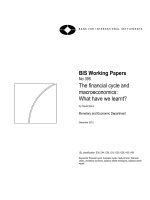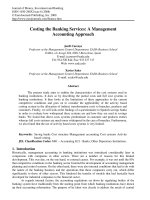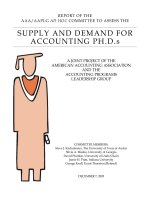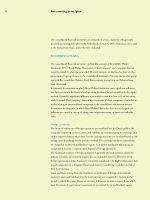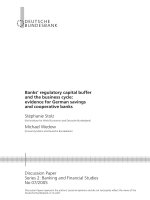Completing the Accounting Cycle potx
Bạn đang xem bản rút gọn của tài liệu. Xem và tải ngay bản đầy đủ của tài liệu tại đây (164.45 KB, 39 trang )
Completing the
Accounting
Cycle
Chapter 4
Prepare an
accounting
work sheet.
Objective 1
The Accounting Cycle
The accounting cycle is the process by
which accountants prepare financial
statements for an entity for a specific
period of time.
The Accounting Cycle
For a new business, begin by setting up
ledger accounts.
For an established business, begin with
account balances carried over from the
previous period.
Accounts Receivable
1,350
Accounts Receivable 1,700
Service Revenue 1,700
Accounts Receivable
1,350
1,700
3,050
Accounts Receivable
1,350
1,700
The Accounting Cycle
Work Sheet
Cash
Accounts
receivable
12,100
3,050
Balance
Sheet
Income
Statement
The Accounting Cycle
Postclosing Trial Balance
Cash
Accounts
receivable
12,100
3,050
Adjusting entries Closing entries
Cash Accounts Receivable
12,100 3,050
The Accounting Cycle
The Accounting Work Sheet
What is the work sheet?
A work sheet is a multi-columned document
used by accountants to help move data from
the trial balance to the financial statements.
It is an internal document.
Adjusted
Trial Balance Adjustments Trial Balance
Account Title Dr. Cr. Dr. Cr. Dr. Cr.
Cash
Accounts receivable
Supplies
Equipment
Accum. depreciation
Accounts payable
Salary payable
Unearned revenue
Capital
Withdrawals
Revenue
Salary expense
Supplies expense
Depreciation expense
Totals
12,100
1,350
250
15,500
1,000
12,000
42,200
7,500
1,200
1,100
1,500
7,200
23,700
42,200
The Accounting Work Sheet
©2002 Prentice Hall, Inc. Business Publishing Accounting, 5/E Horngren/Harrison/Bamber 4 - 9
The Accounting Work Sheet
a
The company has earned revenue of $1,700
which will be collected next month.
b
Inventory of supplies at month end totaled
$150.
c
Depreciation for the period was calculated
as $200.
Adjusted
Trial Balance Adjustments Trial Balance
Account Title Dr. Cr. Dr. Cr. Dr. Cr.
Cash
Accounts receivable
Supplies
Equipment
Accum. depreciation
Accounts payable
Salary payable
Unearned revenue
Capital
Withdrawals
Revenue
Salary expense
Supplies expense
Depreciation expense
Totals
12,100
1,350
250
15,500
1,000
12,000
42,200
7,500
1,200
1,100
1,500
7,200
23,700
42,200
a) 1,700
b) 100
c) 200
2,000
b) 100
c) 200
a) 1,700
2,000
12,100
3,050
150
15,500
1,000
12,000
100
200
44,100
7,700
1,200
1,100
1,500
7,200
25,400
44,100
The Accounting Work Sheet
©2002 Prentice Hall, Inc. Business Publishing Accounting, 5/E Horngren/Harrison/Bamber 4 - 11
Adjusted Income Balance
Trial Balance Statement Sheet
Account Title Dr. Cr. Dr. Cr. Dr. Cr.
Cash
Accounts receivable
Supplies
Equipment
Accum. depreciation
Accounts payable
Salary payable
Unearned revenue
Capital
Withdrawals
Revenue
Salary expense
Supplies expense
Depreciation expense
Totals
7,700
1,200
1,100
1,500
7,200
25,400
44,100
12,10
0
3,050
150
15,500
1,000
12,00
0
100
200
44,10
0
12,10
0
3,050
150
15,500
1,000
31,80
0
7,700
1,200
1,100
1,500
7,200
18,700
The Accounting Work Sheet
©2002 Prentice Hall, Inc. Business Publishing Accounting, 5/E Horngren/Harrison/Bamber 4 - 12
Adjusted Income Balance
Trial Balance Statement Sheet
Account Title Dr. Cr. Dr. Cr. Dr. Cr.
Cash
Accounts receivable
Supplies
Equipment
Accum. depreciation
Accounts payable
Salary payable
Unearned revenue
Capital
Withdrawals
Revenue
Salary expense
Supplies expense
Depreciation expense
Totals
7,700
1,200
1,100
1,500
7,200
25,400
44,100
12,10
0
3,050
150
15,500
1,000
12,00
0
100
200
44,10
0
12,10
0
3,050
150
15,500
1,000
31,80
0
7,700
1,200
1,100
1,500
7,200
18,700
12,000
100
200
12,300
25,400
25,400
The Accounting Work Sheet
©2002 Prentice Hall, Inc. Business Publishing Accounting, 5/E Horngren/Harrison/Bamber 4 - 13
Adjusted Income Balance
Trial Balance Statement Sheet
Account Title Dr. Cr. Dr. Cr. Dr. Cr.
Cash
Accounts receivable
Supplies
Equipment
Accum. depreciation
Accounts payable
Salary payable
Unearned revenue
Capital
Withdrawals
Revenue
Salary expense
Supplies expense
Depreciation expense
Totals
Net income
7,700
1,200
1,100
1,500
7,200
25,400
44,100
12,10
0
3,050
150
15,500
1,000
12,00
0
100
200
44,10
0
12,10
0
3,050
150
15,500
1,000
31,80
0
31,80
0
7,700
1,200
1,100
1,500
7,200
18,700
13,100
31,800
12,000
100
200
12,300
13,100
25,400
25,400
25,400
25,400
The Accounting Work Sheet
©2002 Prentice Hall, Inc. Business Publishing Accounting, 5/E Horngren/Harrison/Bamber 4 - 14
Use the work
sheet
to complete the
accounting cycle.
Objective 2
The work sheet
helps identify
the accounts
that need
adjustments.
Actual adjustment
of the accounts
requires
journalizing
and posting
the entries.
Recording the
Adjusting Entries
Recording the
Adjusting Entries
The adjusting entries may be recorded in
the journal when they are entered on the
work sheet.
Many accountants journalize and post the
adjusting entries just before they make the
closing entries.
Close the revenue,
expense, and
withdrawal
accounts.
Objective 3
Closing the Accounts
Closing the accounts is the end of period
process that prepares the accounts for
recording transactions during the next
period.
Closing Entries
Revenues
increase
Owner’s
Equity.
Expenses
and
Withdrawals
decrease
Owner’s
Equity.
Closing the Accounts
Closing the Accounts
Revenues and Expense accounts are closed
to Income Summary.
Income Summary is closed to Capital.
Withdrawals are closed to Capital.
In a corporation, Dividends are closed to
Retained Earnings.
Income Summary
A credit
balance
represents
net income.
A debit
balance
represents
net loss.
Closing the Accounts
Revenue
Income
Summary
12,000
7,500
9,000
Salary Exp
3,300
28,500
1,500
1,800
4,450
28,500
Rent Exp
800 800
Supplies Exp
350 350
24,050
24,050
(Close Revenue
Account)
(Close Expense
Accounts)
(Close Income
Summary)
Withdrawals
2,500 2,500
2,500
Capital
Account
(Close
Withdrawals
Account)
Closing the Accounts
©2002 Prentice Hall, Inc. Business Publishing Accounting, 5/E Horngren/Harrison/Bamber 4 - 23
Postclosing Trial Balance
The accounting cycle ends with the
postclosing trial balance.
The postclosing trial balance is dated as
of the end of the period for which the
statements have been prepared.
Permanent Accounts
What accounts never close?
–
Assets
–
Liabilities
–
Owner’s equity
Balances of permanent accounts carry over
to the next period.

